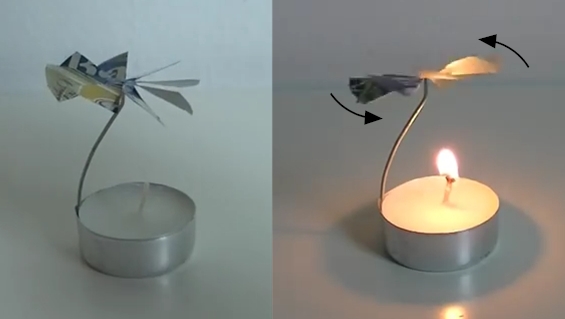Item AP055005: Analyze and interpret data from investigations to identify patterns and use energy transfer ideas to explain the cause for the phenomenon of a fan spinning over a lit candle. (CR version)
A teacher shows her class a demonstration of a fan that spins over a lit candle. The students notice that the fan only spins while the candle is burning.

Watch the video to see the demonstration.
The students want to figure out whether the light from the candle, the air rising from the candle, or both of them are causing the fan to spin. They also want to know if energy plays a role. They conduct a series of investigations by placing a fan over different objects. The table below summarizes their findings.
| Investigation # | Description | Was light observed? | Did air rise toward the fan? | Did the fan start to spin? |
| 1 | The fan is placed over a burning candle. | Yes | Yes | Yes |
| 2 | The fan is placed over a hot plate that is turned on a low setting. | No | Yes | Yes |
| 3 | The fan is placed over an LED light bulb that is turned on. | Yes | No | No |
1. Based on the observations in the table, which of the following explains what caused the fan to spin?
A. The fan spins because of the light.
B. The fan spins because air is moving toward the fan.
C. Both the light and the moving air cause the fan to spin.
D. Neither the light nor the moving air causes the fan to spin.
2. What patterns in the data helped you decided whether light caused the fan to spin?
3. What patterns in the data helped you decided whether moving air caused the fan to spin?
4. One way to relate light, heat, and motion is through energy. Use ideas about light, heat, motion, and energy to explain why the fan moves during Investigations 1 and 2. Be sure to include evidence from the investigations in your explanation.
- Percent of Points Earned

- Points Earned
| Avg. Earned | Possible | Percent | |
|---|---|---|---|
| Q1 | 0.61 | 1 | 61% |
| Q2 | 0.49 | 2 | 25% |
| Q3 | 0.59 | 2 | 30% |
| Q4 | 0.27 | 4 | 7% |
- Overall Task Difficulty
| Total Points Earned | Total Points Possible | Total Percent | |
|---|---|---|---|
| 1.96 | 9 | 22% |
n = 281
Note: The total percent is a weighted average based on the total number of points earned divided by the total number of points possible.
- Science and Engineering Practices
- SEP4 Analyze and interpret data to provide evidence for phenomena.
SEP6 Apply scientific ideas, principles, and/or evidence to construct, revise and/or use an explanation for realworld phenomena, examples, or events. - Crosscutting Concepts
- CC1 Patterns can be used to identify cause and effect relationships.
- Disciplinary Core Ideas
- PS3.C When two objects interact, each one exerts a force on the other that can cause energy to be transferred to or from the object.

